A Study on the Psychological Noise Reduction Effect on Dental Handpiece Noise through the Bone Conduction Speaker Equipped Unit Chair and Notch-Filtered Music
Abstract
1. Introduction
2. Methods
2.1. Development of Unit Chair with Bone Conduction Speaker
2.2. Development of Notch-Filtered Music through Sound Masking Technology
2.3. Experiments
3. Results
3.1. Survey Results of Noise Reduction Effect and Emotional Change
3.2. Preference and Evoked Emotion Survey Results for Each Sound Source
4. Discussion
5. Conclusions
Author Contributions
Funding
Institutional Review Board Statement
Informed Consent Statement
Data Availability Statement
Conflicts of Interest
Appendix A. Patient′s Music Selection List
| Patient No. | Title | Artist | Genre |
|---|---|---|---|
| P1 | My Universe | BTS and Coldplay | Rock |
| P2 | Modeun nal, modeun sungan | Paul Kim | Ballade |
| P3 | Next Level | Aespa | Dance |
| P4 | Butter | BTS | Dance |
| P5 | Back in Black | ACDC | Rock |
| P6 | Dambaegage agassi | YB | Rock |
| P7 | Eotteohge ibyeolkkaji Saranghagesseo | AKMU | Ballade |
| P8 | Sorry Sorry | Super Junior | Dance |
| P9 | Johannes Brahms, String Sextet No. 1 In B Flat Major, Op. 18 | Amadeus Quartet | Classic |
| P10 | Byeolboreo gaja | Juk Jae | Ballade |
| P11 | Celebrity | IU | Dance |
| P12 | Garasadae | BewhY | Hip Hop |
| P13 | Georieseo | Sung Si Kyung | Ballade |
| P14 | Geujunge geudaereul manna | Lee Sun Hee | Ballade |
| P15 | Tornado of Souls | Megadeath | Rock |
| P16 | Singiru | C JAMM | Hip Hop |
| P17 | I Believe | Shin Seung Hun | Ballade |
| P18 | Tchaikovsky-String Quartet No. 1 In D Major, Op. 11 | Emerson String Quartet | Classic |
| P19 | Savage | Aespa | Dance |
| P20 | Stockholm Syndrome | Muse | Rock |
| P21 | Uptown Funk | Bruno Mars | Dance |
| P22 | I′m Not the Only One | Sam Smith | Ballade |
| P23 | No Song Without You | Honne | R&B |
| P24 | Nai | Yoon Jong-Shin | Ballade |
| P25 | Mommae | Jay Park | Hip Hop |
| P26 | Anajwo | Jung JoonIl | Ballade |
| P27 | Basket Case | Green Day | Rock |
| P28 | 200% | AKMU | Dance |
| P29 | Chobulhana | GOD | Ballade |
| P30 | Butter | BTS | Dance |
| P31 | Naege oneun gil | Sung Si Kyung | Ballade |
| P32 | Joheun nal | IU | Dance |
| P33 | Next Level | Aespa | Dance |
| P34 | Nakha | AKMU | Dance |
| P35 | Geokjeongmarayo Geudae | Juck Lee | Ballade |
References
- Ji, D.-H.; Choi, M.-S. Characteristics of noise radiated at dental clinic. JKSEE 2009, 31, 1123–1128. [Google Scholar]
- Bhandary, N.; Desai, A.; Shetty, Y.B. High speed handpieces. Int. J. Oral Health Dent. 2014, 6, 130. [Google Scholar]
- Demenberg, J. Anti-noise; Quieting the environment with active noise cancellation technology. IEEE Potentials 1992, 11, 36–40. [Google Scholar]
- Song, E.-S.; Lim, Y.-J.; Lee, J.; Moon, J.-B.; Kim, B.J. Application of Soundproofing Materials for Noise Reduction in Dental CAD/CAM Milling Machines. Appl. Sci. 2020, 10, 2768. [Google Scholar] [CrossRef]
- Kim, I.-H.; Cho, H.; Song, J.S.; Park, W.; Shin, Y.; Lee, K.E. Assessment of Real-Time Active Noise Control Devices in Dental Treatment Conditions. Int. J. Environ. Health Res. 2022, 19, 9417. [Google Scholar] [CrossRef] [PubMed]
- Ainscough, S.; Windsor, L.; Tahmassebi, J. A review of the effect of music on dental anxiety in children. Eur. Arch. Paediatr. Dent. 2019, 20, 23–26. [Google Scholar] [CrossRef] [PubMed]
- Kupeli, I.; Gülnahar, Y. Comparing different music genres in decreasing dental anxiety in young adults who underwent third molar surgery in Turkey: Randomized controlled trial. J. Oral Maxillofac. Surg. 2020, 78, 546.e1–546.e7. [Google Scholar] [CrossRef] [PubMed]
- Mathivadani, V.; Anjali, A.; Arivarasu, L. Awareness regarding impact of music on patients anxiety during dental treatments. Eur. J. Mol. Clin. Med. 2020, 7, 2020. [Google Scholar]
- Moola, S.; Pearson, A.; Hagger, C. Effectiveness of music interventions on dental anxiety in paediatric and adult patients: A systematic review. JBI Evid. Synth. 2011, 9, 588–630. [Google Scholar] [CrossRef] [PubMed]
- Wilson, C.; Vaidyanathan, T.; Cinotti, W.; Cohen, S.; Wang, S. Hearing-damage risk and communication interference in dental practice. J. Dent. Res. 1990, 69, 489–493. [Google Scholar] [CrossRef] [PubMed]
- Lakshmi, K.; Madankumar, P.D. Development of modified dental chair to accomodate both wheelchair bound patients and general population. Disabil. Rehabil. Assist. Technol. 2020, 15, 467–470. [Google Scholar] [CrossRef] [PubMed]
- Hongisto, V.; Varjo, J.; Leppämäki, H.; Oliva, D.; Hyönä, J. Work performance in private office rooms: The effects of sound insulation and sound masking. Build. Environ. 2016, 104, 263–274. [Google Scholar] [CrossRef]
- Cai, J.; Liu, J.; Yu, N.; Liu, B. Effect of water sound masking on perception of the industrial noise. Appl. Acoust. 2019, 150, 307–312. [Google Scholar] [CrossRef]
- Plack, C.J.; Oxenham, A.J.; Drga, V. Linear and nonlinear processes in temporal masking. Acta Acust. United Acust. 2002, 88, 348–358. [Google Scholar]
- Stenfelt, S. Transcranial attenuation of bone-conducted sound when stimulation is at the mastoid and at the bone conduction hearing aid position. Otol. Neurotol. 2012, 33, 105–114. [Google Scholar] [CrossRef] [PubMed]
- Mo, S.; Kang, J.; Kim, I.-H.; Choi, H.-J.; Song, J.S.; Shin, Y. Effect of Noise Cancelling Devices on Dental Handpieces Using Ear Model. J. Korean Acad. Pediatr. Dent. 2020, 47, 62–69. [Google Scholar] [CrossRef][Green Version]
- Okamoto, H.; Stracke, H.; Stoll, W.; Pantev, C. Listening to tailor-made notched music reduces tinnitus loudness and tinnitus-related auditory cortex activity. Proc. Natl. Acad. Sci. USA 2010, 107, 1207–1210. [Google Scholar] [CrossRef] [PubMed]
- Jacobsen, F. Sound intensity. In Springer Handbook of Acoustics; Springer: Berlin/Heidelberg, Germany, 2014; pp. 1093–1114. [Google Scholar]
- Tayib, S.; Jamaludin, Z. An algorithm to define emotions based on facial gestures as automated input in survey instrument. Adv. Sci. Lett. 2016, 22, 2889–2893. [Google Scholar] [CrossRef]
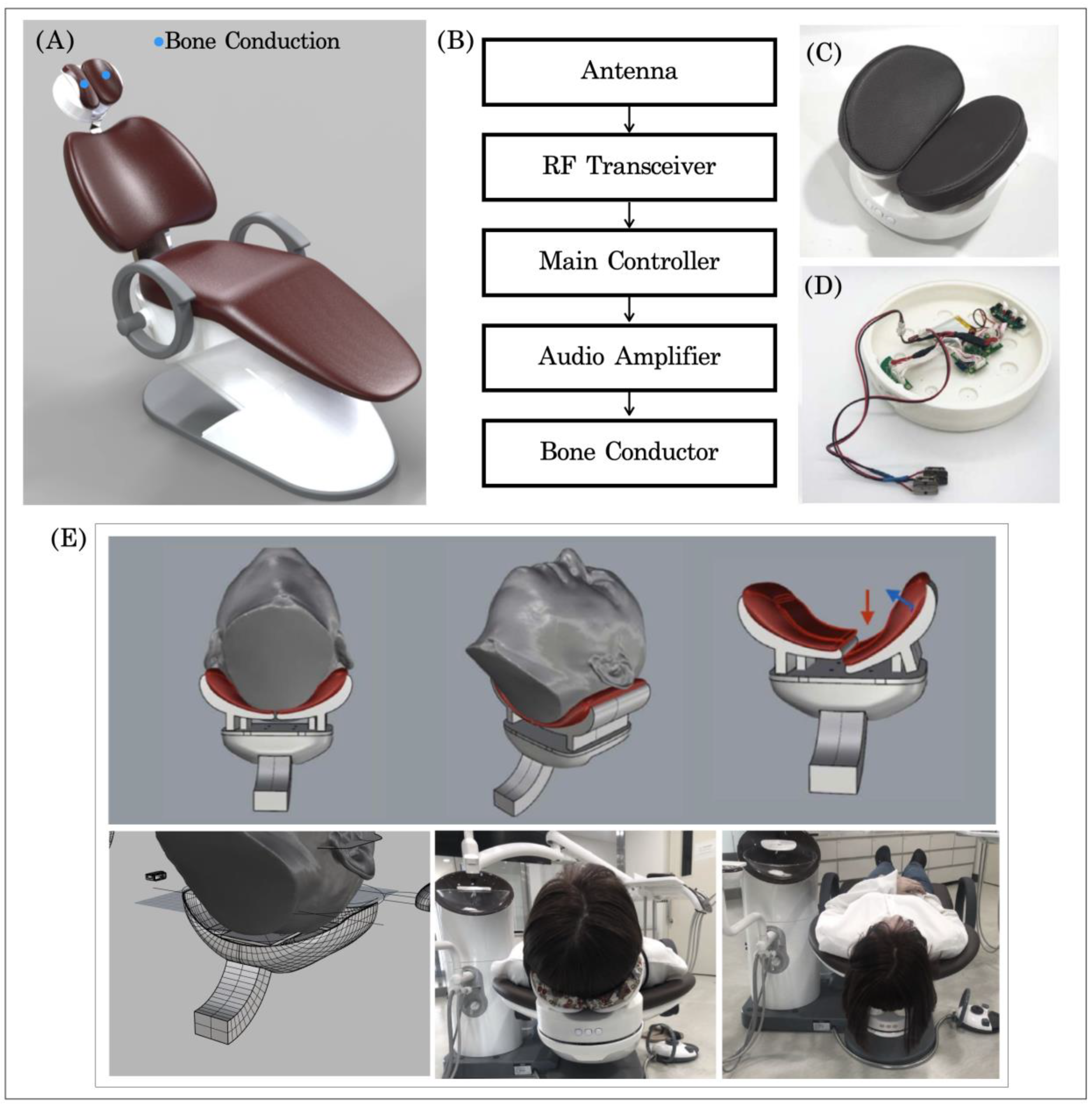
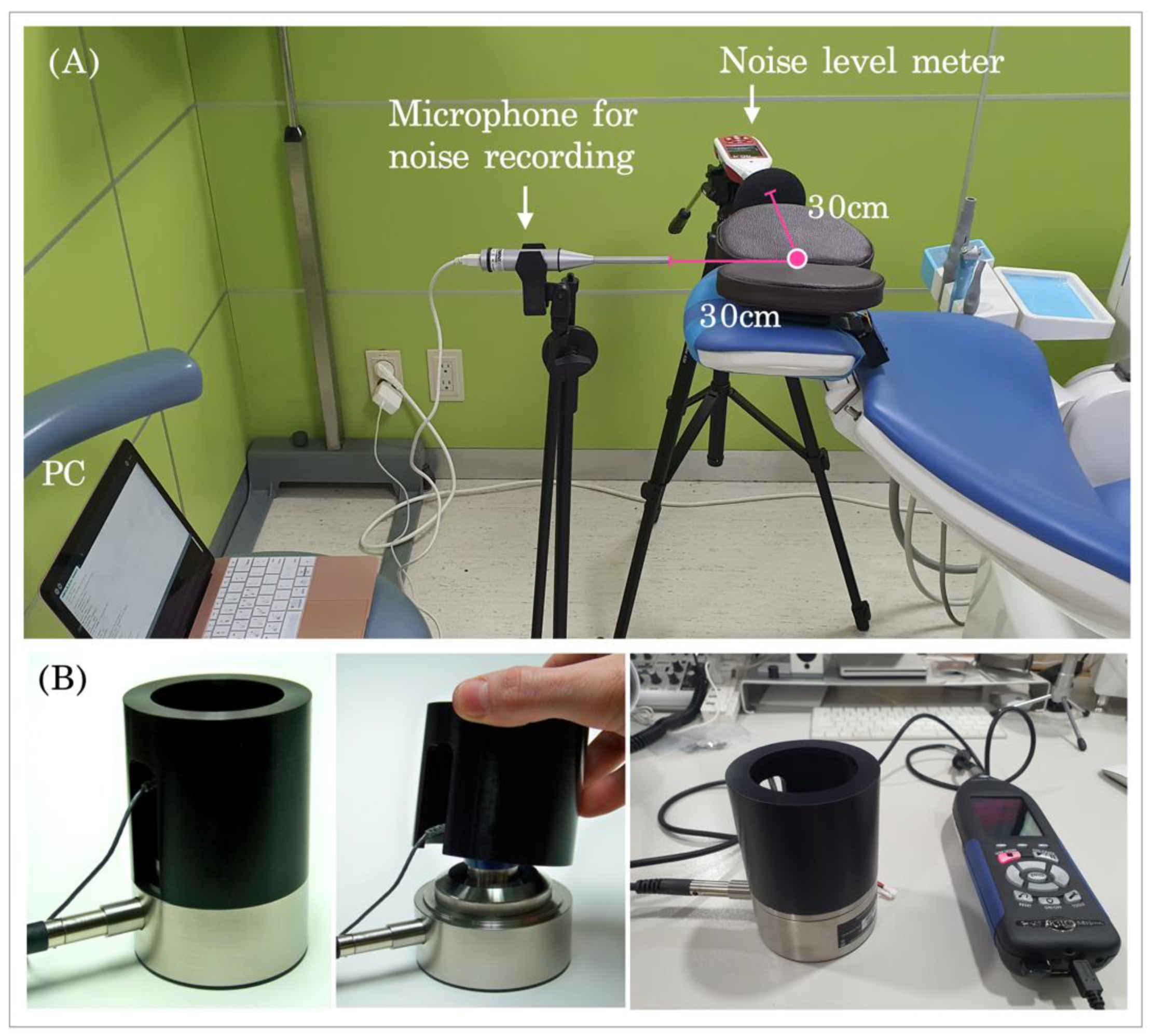

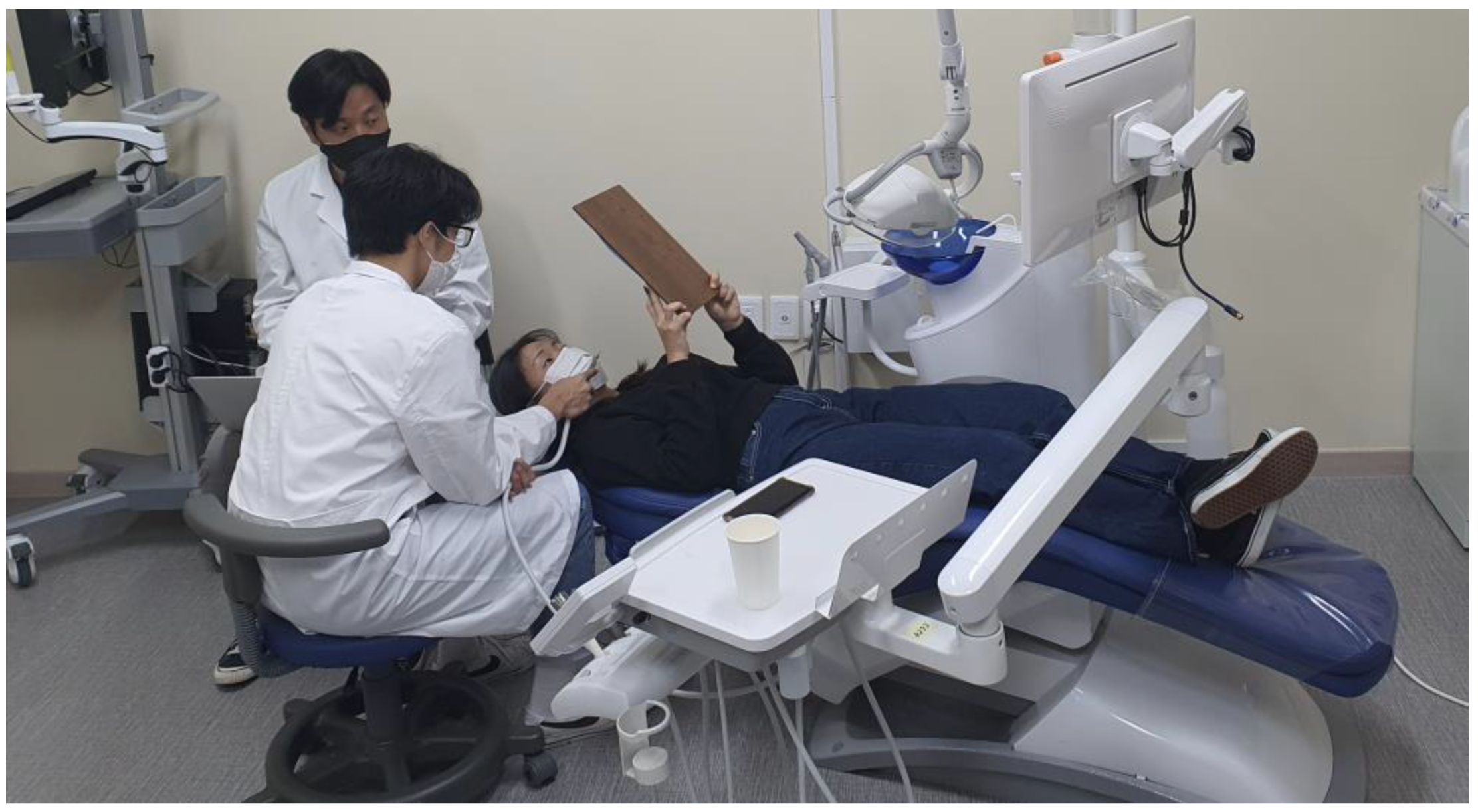
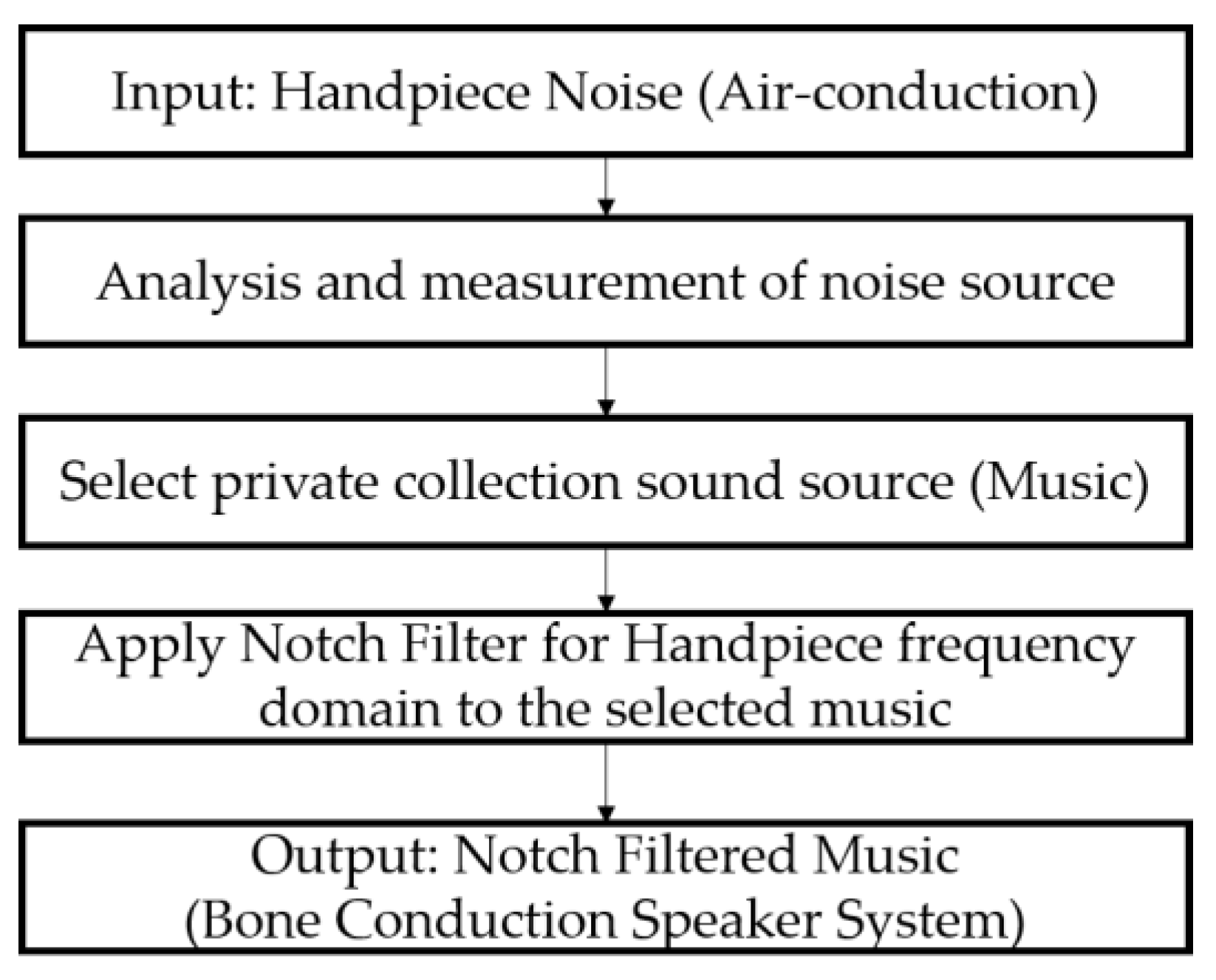
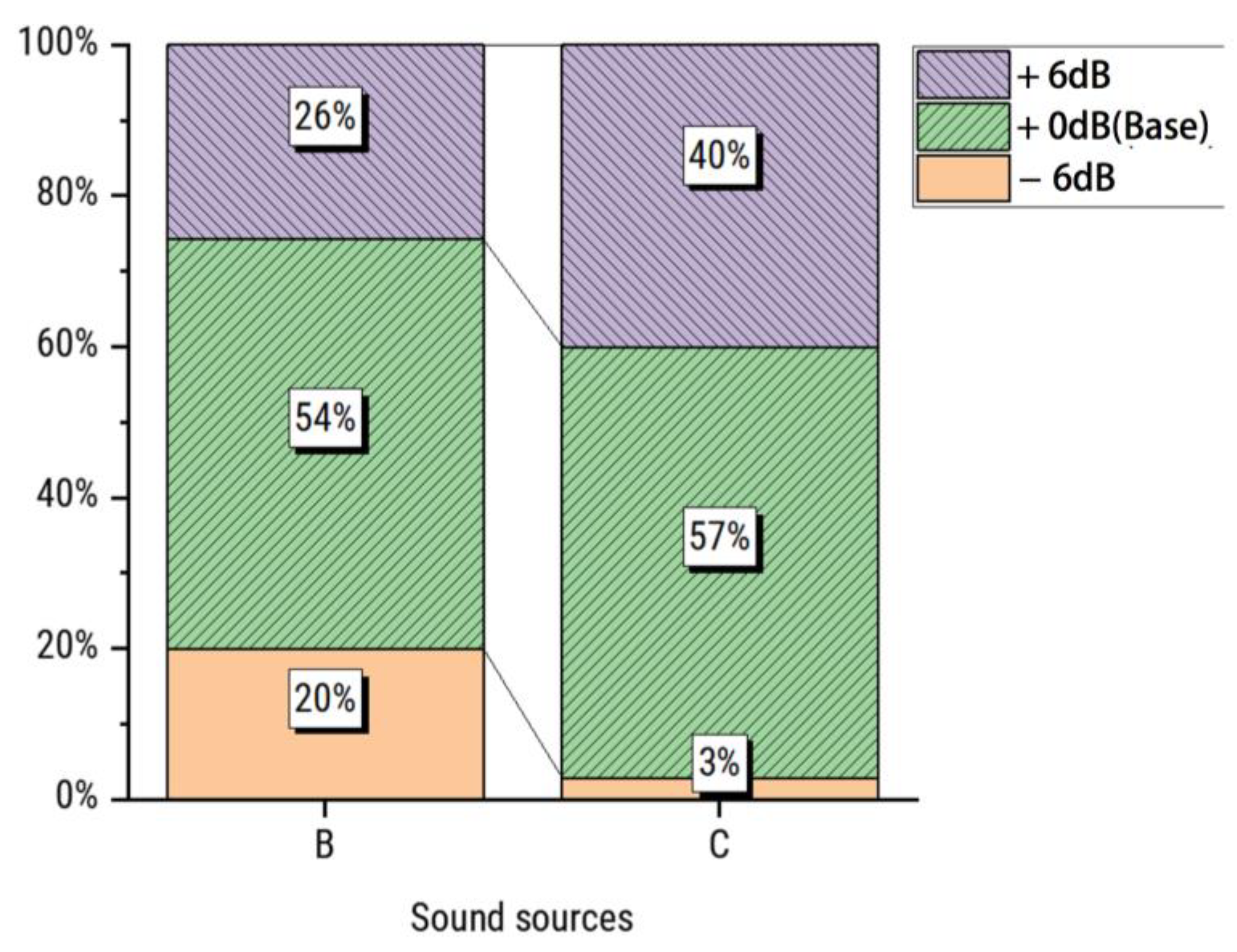
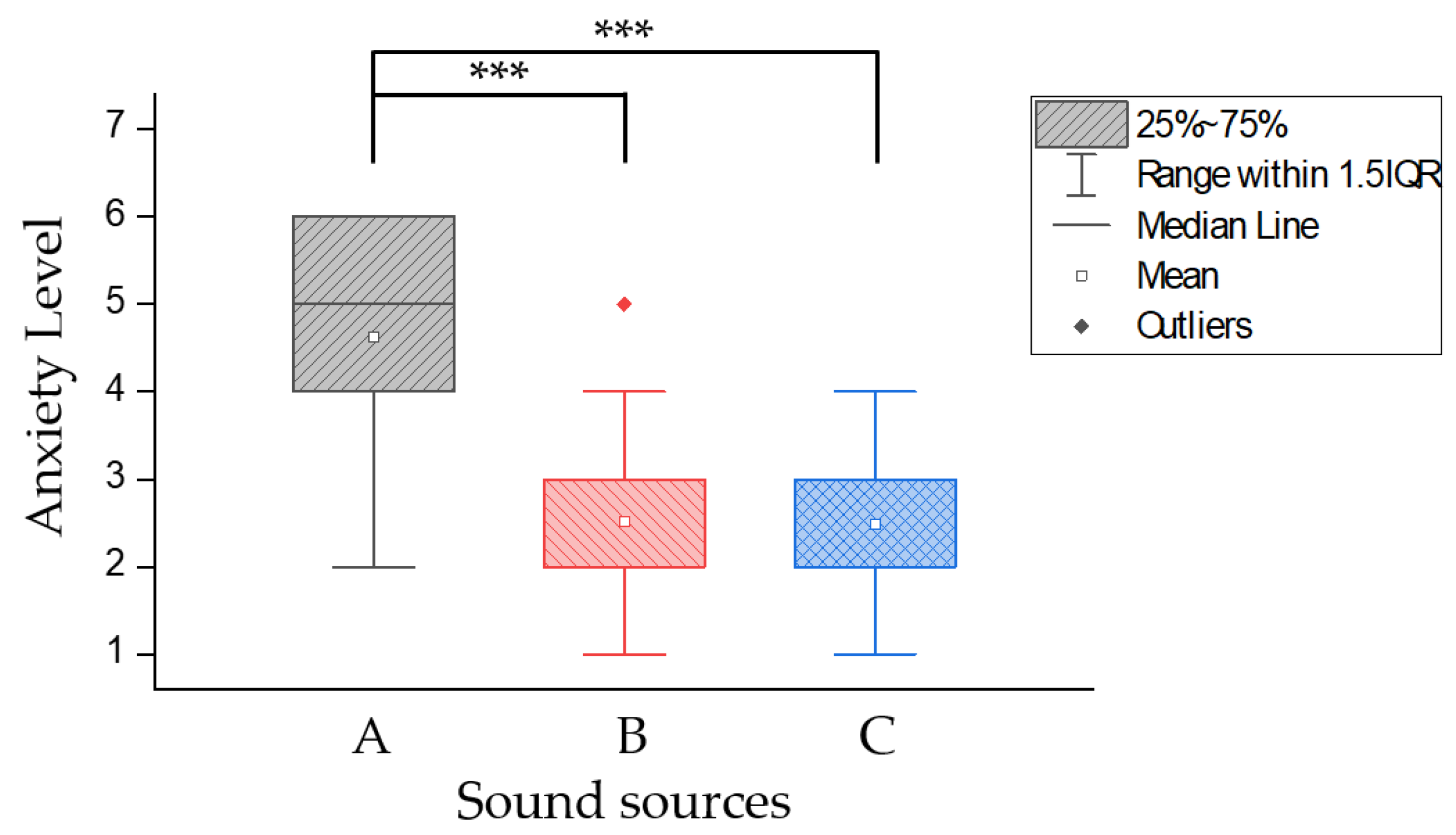

| Equipment | Company/Model |
|---|---|
| Dental Handpiece | TI-Max Z900 (NSK-Nakanishi International, Shimohinata, Japan) |
| Sound Level Meter | CK:161A (Cirrus, Sywell, UK) |
| Microphone | Zoom H6 and SSH-6 (Zoom, Tokyo, Japan) |
| Bone Conduction Transducer | BCE-1 22 × 14 mm2 Bone Conducting Exciter (Dayton Audio, Springboro, OH, USA) |
| Amplifier | MH-M18 (SMG, Shanghai, China) |
| Audiometer | AMC493B (Larson Davids, Depew, NY, USA) |
| Sound sources | A: (Base) Handpiece noise |
| B: Handpiece noise + Music | |
| C: Handpiece noise + Notch-filtered music | |
| Subjective noise intensity | 6 dB |
| 0 dB | |
| 6 dB |
| Music (Ex: BTS, “Butter”) | Notch-Filtered Music | |
|---|---|---|
| Total RMS Amplitude | −15.89 dB | −18.36 dB |
| Average RMS Amplitude | −18.80 dB | −20.06 dB |
| Loudness (Legacy) | −14.36 dB | −17.61 dB |
Disclaimer/Publisher’s Note: The statements, opinions and data contained in all publications are solely those of the individual author(s) and contributor(s) and not of MDPI and/or the editor(s). MDPI and/or the editor(s) disclaim responsibility for any injury to people or property resulting from any ideas, methods, instructions or products referred to in the content. |
© 2022 by the authors. Licensee MDPI, Basel, Switzerland. This article is an open access article distributed under the terms and conditions of the Creative Commons Attribution (CC BY) license (https://creativecommons.org/licenses/by/4.0/).
Share and Cite
Jo, Y.; Kang, W.; Hong, S.; Bandoy, J.V.; Kwon, H.-S.; Kim, H.; Song, E. A Study on the Psychological Noise Reduction Effect on Dental Handpiece Noise through the Bone Conduction Speaker Equipped Unit Chair and Notch-Filtered Music. Appl. Sci. 2023, 13, 359. https://doi.org/10.3390/app13010359
Jo Y, Kang W, Hong S, Bandoy JV, Kwon H-S, Kim H, Song E. A Study on the Psychological Noise Reduction Effect on Dental Handpiece Noise through the Bone Conduction Speaker Equipped Unit Chair and Notch-Filtered Music. Applied Sciences. 2023; 13(1):359. https://doi.org/10.3390/app13010359
Chicago/Turabian StyleJo, Yeabon, Woojin Kang, Sungwoo Hong, Joseph Vermont Bandoy, Hyuk-Sang Kwon, Heejung Kim, and Eunsung Song. 2023. "A Study on the Psychological Noise Reduction Effect on Dental Handpiece Noise through the Bone Conduction Speaker Equipped Unit Chair and Notch-Filtered Music" Applied Sciences 13, no. 1: 359. https://doi.org/10.3390/app13010359
APA StyleJo, Y., Kang, W., Hong, S., Bandoy, J. V., Kwon, H.-S., Kim, H., & Song, E. (2023). A Study on the Psychological Noise Reduction Effect on Dental Handpiece Noise through the Bone Conduction Speaker Equipped Unit Chair and Notch-Filtered Music. Applied Sciences, 13(1), 359. https://doi.org/10.3390/app13010359






